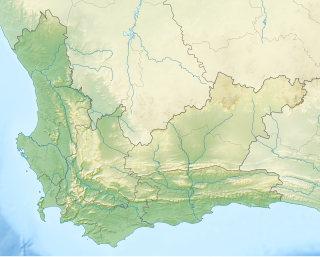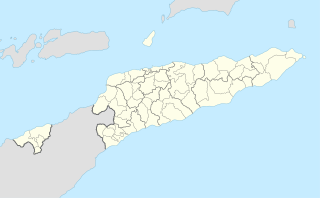
East Timor is a country in Southeast Asia and Oceania known as Democratic Republic of Timor-Leste. The country comprises the eastern half of the island of Timor and the nearby islands of Atauro and Jaco. The first inhabitants are thought to be descendant of Australoid and Melanesian peoples. The Portuguese began to trade with Timor by the early 16th century and colonised it throughout the mid-century. Skirmishing with the Dutch in the region eventually resulted in an 1859 treaty for which Portugal ceded the western half of the island. Imperial Japan occupied East Timor during World War II, but Portugal resumed colonial authority after the Japanese surrender.

Wallacea is a biogeographical designation for a group of mainly Indonesian islands separated by deep-water straits from the Asian and Australian continental shelves. Wallacea includes Sulawesi, the largest island in the group, as well as Lombok, Sumbawa, Flores, Sumba, Timor, Halmahera, Buru, Seram, and many smaller islands. The islands of Wallacea lie between the Sunda Shelf to the west, and the Sahul Shelf including Australia and New Guinea to the south and east. The total land area of Wallacea is 347,000 km2 (134,000 sq mi).

Stegodon, meaning "roofed tooth" because of the distinctive ridges on the animal's molars, is a genus of the extinct subfamily Stegodontinae of the order Proboscidea. It was assigned to the family Elephantidae, but has also been placed in the Stegodontidae. Stegodonts were present from 11.6 million years ago (Mya) to the late Pleistocene, with unconfirmed records of localized survival until 4,100 years ago. Fossils are found in Asian and African strata dating from the late Miocene; during the Pleistocene, they lived across large parts of Asia and East and Central Africa, and in Wallacea as far east as Timor.
Howiesons Poort is a lithic technology cultural period in the Middle Stone Age in Africa named after the Howieson's Poort Shelter archeological site near Grahamstown in South Africa. It seems to have lasted around 5,000 years between roughly 65,800 BP and 59,500 BP.

Qesem cave is a Lower Paleolithic archeological site near the city of Kafr Qasim in Israel. Early humans were occupying the site by 400,000 until c. 200,000 years ago.

Tutuala is a village and suco in the subdistrict of Tutuala. It is situated at the extreme eastern end of Timor. Its population at the 2004 census was 3,707. The subdistrict of Tutuala comprises two sucos, including Mehara and Tutuala with the subdistrict administrator residing in Tutuala. The suco of Tutuala comprised four hamlets (aldeia): Ioro, Pitileti, Tchailoro, and Vero. The main Fataluku language areas of the country are in Tutuala, as well as Lautem and Fuiloro.

The Lena Hara cave is the main cave of a system of solutional caves in the Lautém District at the eastern tip of East Timor (Timor-Leste), close to the village of Tutuala. Others are Ile Kére Kére and Jerimalai. Lene Hara has provided evidence that Timor has been occupied by humans since at least 35,000 years BP and thus is evidence that humans crossed the waters of Wallacea between the Pleistocene continents of Sunda and Sahul.
The Xalnene Tuff footprints are a geological academic controversy, concerning a 2005 discovery of 269 markings in a geological layer in the Valsequillo Basin, south of the city of Puebla, Mexico, which were originally interpreted to be human and animal footprints. The layer was variously dated to 40,000 years Before Present (BP) or 1.3 million years BP, both dates significantly before the currently accepted date for the settlement of the Americas. A 2010 study argues that the marks were made by recent mining activities.

Theopetra Cave is located in Thessaly, Greece, on the north-east side of a limestone rock formation, 3 km (2 mi) south of Kalambaka. The site has become increasingly important as human presence is attributed to all periods of the Middle and Upper Paleolithic, the Mesolithic, Neolithic and beyond, bridging the Pleistocene with the Holocene.

Ngalue Cave is an archaeological site located in the Niassa province of Mozambique. Excavated primarily by Julio Mercader in 2007, Ngalue is a Middle Stone Age site. Due to its relatively dry environment and the shape of the cave, Ngalue had very good preservation and not only were stone tools and animal bones found. There were preserved starch grains on many of the stone tools as well. Overall, this site can help add to our knowledge of the Middle Stone Age site in the Niassa valley and to our understanding of the subsistence of Middle Stone Age peoples in Eastern Africa as a whole.

Boomplaas Cave is located in the Cango Valley in the foothills of the Swartberg mountain range, north of Oudtshoorn, Eden District Municipality in the Western Cape Province, South Africa. It has a 5 m (16 ft) deep stratified archaeological sequence of human presence, occupation and hunter-gatherer/herder acculturation dating back 80,000 years. The site's documentation contributed to the reconstruction of palaeo-environments in the context of changes in climate within periods of the Late Pleistocene and the Holocene. The cave has served multiple functions during its occupation, such as a kraal (enclosure) for animals, a place for the storage of oil rich fruits and as a hunting camp. Circular stone hearths and calcified dung remains of domesticated sheep as well as stone adzes and pottery art were excavated indicating that humans lived at the site and kept animals.

Southwest Asian Neanderthals were Neanderthals who lived in Turkey, Lebanon, Syria, Palestine, Israel, Iraq, and Iran - the southernmost expanse of the known Neanderthal range. Although their arrival in Asia is not well-dated, early Neanderthals occupied the region apparently until about 100,000 years ago. At this time, Homo sapiens immigrants seem to have replaced them in one of the first anatomically-modern expansions out of Africa. In their turn, starting around 80,000 years ago, Neanderthals seem to have returned and replaced Homo sapiens in Southwest Asia. They inhabited the region until about 55,000 years ago.

Jerimalai is a limestone cave southeast of Tutuala, on the eastern tip of East Timor. Fish remains and fish hooks excavated in Jerimalai provide evidence for advanced fishing technique by inhabitants of Timor 42,000 years ago.

Laili is a limestone cave located near the town of Laleia, Manatuto District, East Timor. Archeological findings in Laili provide evidence that the cave was occupied by modern humans 44,600 years ago, making it the second oldest known such habitation in Wallacea aside from Madjedbebe in mainland Northern Australia.
Sue O'Connor is an Australian archaeologist and Distinguished Professor in the School of Culture, History & Language at the Australian National University. Her research focuses primarily on the evidence of Pleistocene settlement and early human migration in the Indo-Pacific region.

Tropicagama is a genus of large-bodied lizards in the family Agamidae. The genus is monotypic, with only one species listed: Tropicagama temporalis, commonly known as the swamplands lashtail or northern water dragon. This semi-arboreal species inhabits the tropical savannah woodlands of northern Australia, as well as parts of New Guinea and southeastern Indonesia.
Roger Michael Jacobi was a British archaeologist specialising in Palaeolithic and Mesolithic Britain. Known for his encyclopaedic knowledge of British prehistory, Jacobi authored several key synthetic volumes and worked to catalogue, sequence and reanalyse collections from across Britain and northwestern Europe. Sections of his extensive personal archive were posthumously published as the Palaeolithic and Mesolithic Artefact (PaMELA) database. He studied archaeology at Jesus College, Cambridge, and held positions at Lancaster University, the University of Nottingham, and the British Museum.
This article records new taxa of fossil primates of every kind are scheduled to be described during the year 2019, as well as other significant discoveries and events related to paleontology of primates that are scheduled to occur in the year 2019.

The Uluzzian Culture is a transitional archaeological culture between the Middle paleolithic and the Upper Paleolithic, found in Italy and Greece.















